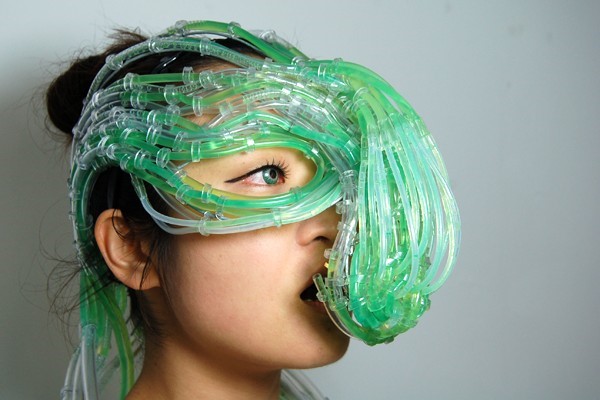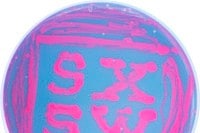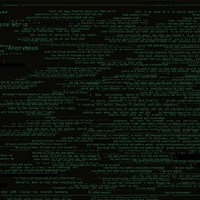Jalia Essaïdi creates bullet-stopping skin by genetically hacking human flesh. But is it art?
Observing Jalia Essaidi's work “2.6g 329m/s,” one witnesses a skein of human flesh stop a speeding bullet in its tracks. The sheer force of the ballistic send ripples coursing through the gelatinous dreamcatcher, the improbable act captured in mesmerising slow motion footage. Jaw dropping yes, but is it art? That tired adage can be levelled at many forms of contemporary art but it holds a particular resonance for the field of bioart which, notable exceptions aside, has been in the public eye for barely 20 years.
Bioart today is undoubtedly indebted to the trails blazed by the Tissue Culture and Art Project (TCA) founders Oron Catts and Ionat Zurr. Together they established a lab-cum-studio alongside the Perth Institute of Contemporary Art and created internationally exhibited projects which ignited imaginations: a leather jacket grown in a test tube, a frogs leg steak served up fresh from the petri dish. The duo translated the established lab technique of tissue culturing into artworks that opened a public window into biotechnologies.
Four years later, the pair helped established Symbiotica at the University of Western Australia, a research lab aimed at fuelling international collaborations between artists and the university’s science labs. A canon of bioart began to emerge, and techniques which had previously been exclusive stalwarts of science labs began trickling down to curious artists. Catts and Zurr continue to make provocative “semi-living” artworks and hold international workshops with other artists keen to learn the ropes of biomedia.
Essaïdi genetically engineered human-skin cells to express a protein usually found in spider silk, which, when woven, possesses a strength that surpasses steel:“I wanted to inspire a sense of awe for this huge machine that we call nature, and the mechanics by which it produced all these ingenious constructs”, she said
“2.6g 329m/s” was made possible by tissue-culturing techniques – Essaïdi created her bullet-stopping skin by genetically engineering human-skin cells to express a protein usually found in spider silk, which, when woven, possesses a strength that surpasses steel.
Today's genetic technologies are sufficiently advanced that the spiders genome can be sequenced, the sequence of DNA that creates the strong silk protein isolated, and that same sequence of DNA instructions transplanted into other living creatures to 'manufacture' the silk in bulk. The most infamous case of this was Nexia Biotechnologies’ BioSteel fibre, created from the milk of transgenics goats. Essadi states that “I wanted to inspire a sense of awe for this huge machine that we call nature, and the mechanics by which it produced all these ingenious constructs that have been fine-tuned and enhanced over millions of years”
Essadi created her artwork 17 years after the silk protein was patented by Dr. Randy Lewis of Utah State University, and she was the first experimenter to combine it with a full thickness skin model. This contrasts starkly to the lag between tissue culturings invention (1907), and TCA's uptake of the method (1996). in 2013 BioArt is hot on the heels of the most exciting biotechnological advances. Genetically modified organisms (GMOs) are manufactured by synthetic biology research labs in the hopes of optimising photosynthesis, coaxing diesel from ponds of genetically engineered algae and devising new cures for ailments by reprogramming bacteria into medicinal nanomachines. Synthetic biology is a scientific discipline that treats organisms as living machines awaiting genetic reprogramming. CohenVanBalen, the design partnership of Tuur Van Balen and Revital Cohen, produce work against a backdrop of such scientific advances. Tuur Van Balen's Pigeon D'or devised a way to transform urban pigeons shit into soap by reprogramming the pigeons gut bacteria. “Pigeon D'or developed from approaching the city as an organism, and the bacteria is the material we use to rewrite urban metabolic pathways” Tuur says The bacteria that performs the faecal alchemy is not present in any living pigeons, but the shit-to-soap gene is available on the Biobrick Standard registry of Biological Parts. “Anyone can access the design and create the bacteria using the biobrick” (the name applied to genes intended to be used in modular fashion, like building a genome from lego bricks).
Tuur Van Balen's Pigeon D'or devised a way to transform urban pigeons shit into soap by reprogramming the pigeons gut bacteria
Tuur Van Balen and Essaidi, like the Symbiotica residents before them, have been fortunate to work in collaboration with institutional laboratories. Jennifer Willet, a former Symbiotica resident herself, uses the lab environment as inspiration for her artistic interventions: establishing pop-up labs deep in the woods or amidst civic environments (as in the forthcoming Eco Nuit Parade). Her BioARTCAMP of 2011 (the subject of a recent documentary) saw collaborators recreate genetic lab technology using log fires and tin buckets. Willet states that “I'm interested in producing works that consider the laboratory itself as an ecology. I see ecological metaphors as allowing us to engage more directly in the complex bioethics of the biological sciences”. Willet's unconventional labs occur in parallel with a kindred trend, that of biohackers learning genetic engineering the “do it with others” (DIWO) way. Amateur scientists and enthusiasts gather in community run hacklabs, and reverse engineer the scientific techniques used in genetic engineering. These so-called DIYBio spaces have spread across the globe, from New York to Manchester, Slovenia to Indonesia. Nurit Bar-Shai, bioartist and co-founder of Genspace NYC, sheds some light on what made DIYbio spaces possible. “During the years after the dot com bust major advances in technology and bio-tech made it cheaper to tinker with science and work with biology. Then the recession of 2008 brought a wave of social changes and heightened awareness of ecological precarity and scarcity of resources around the world. During that time many labs and biotech startups bankrupted. Most of Genspace's equipment was donated to us by a lab that closed down after the recession”.
On the global stage biohacking collective Hackteria has lead the way on demystifing bioart and providing people with easy practical ways to engage with it. Formed in 2009 and featuring chapters in Europe, India and Indonesia the Hackteria Wikipedia has become the de-facto resource for all budding biohackers. The interplay between biohacking and bioart is particularly fluid among Hackteria affiliated practitioners. “Hackteria is not, generally speaking, about finished products or finished works. The bioart just happens, but is not the primary goal” said Hackteria co-founder Marc Dusseiller. Some of that 'incidental bioart' has been quite sublime. Hackteria co-founder Yashas Shetty lead the Art Science bangalore collective in producing 'Teenage Gene Poems'. Together the team isolated the enzyme (Geosmin) responsible for that 'just after rain' smell, and engineered a bacteria to produce that smell on demand, thus creating a bioart poem about the monsoon. Just as the lab finds itself transplanted outside it's usual environs so too does BioArt find itself exhibited in unexpected locales: Teenage Gene Poems has not only toured notable art festivals but has also won accolades at the iGEM (international genetically engineered machine) competition. iGEM is the science fair of synthetic biology, with college students from across the globe competing to engineer living machines.
Check out part two of this BioArt feature with more of Hackteria's DIY Bioelectronix, the perils of BioArt activism and a Scientist who's turned to the 'dark side' of BioArt.










